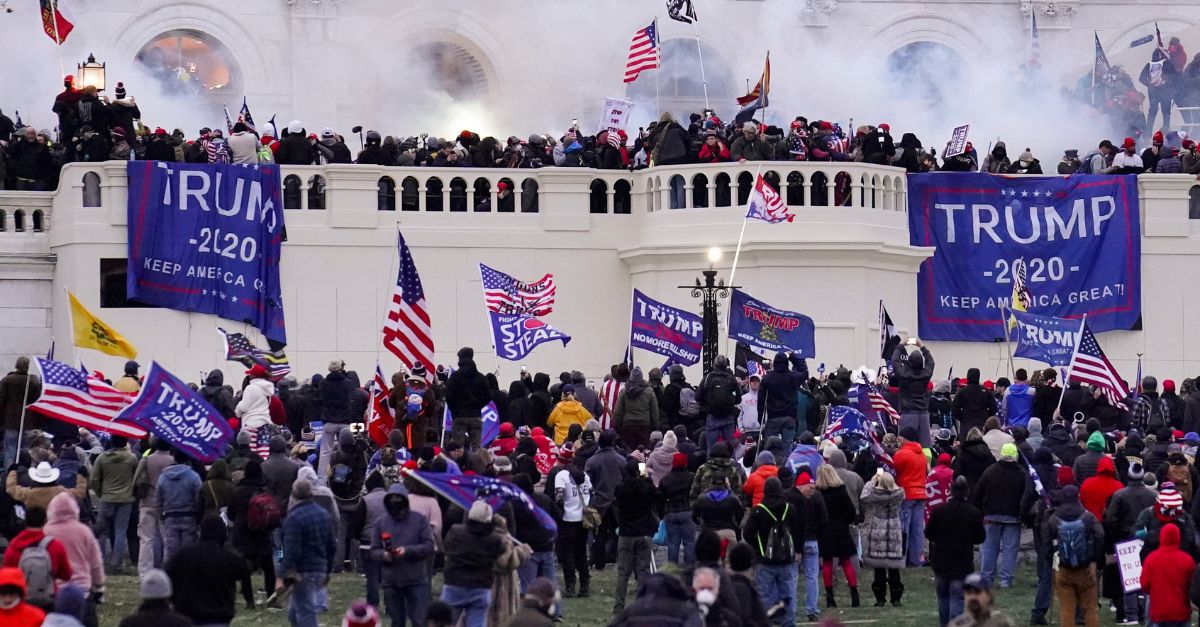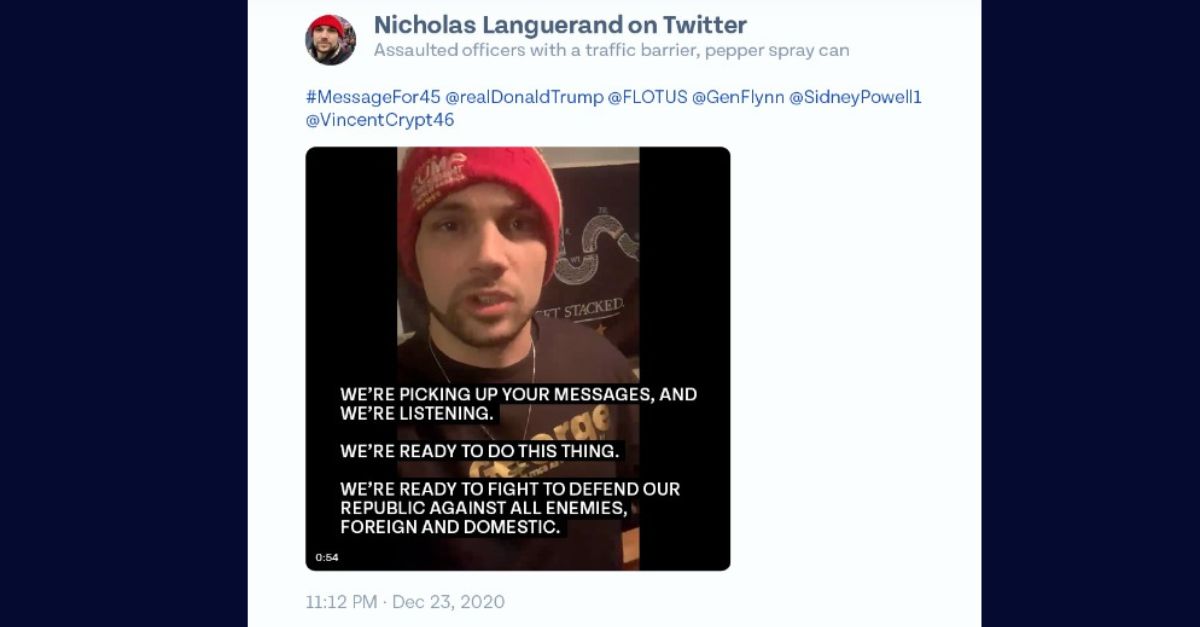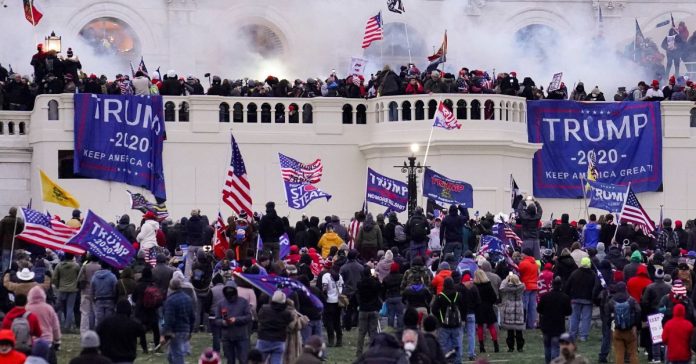
Violent rioters supporting President Donald Trump storm the Capitol in Washington, Wednesday, Jan. 6, 2021. (AP Photo/John Minchillo, File)
A new assessment of public records by a federal watchdog group has found that approximately 210 defendants charged with crimes connected to Jan. 6 directly expressed that they only came to Washington, D.C., or joined in on the violence at the U.S. Capitol because they were incited by former President Donald Trump and heeding his call.
The report was published Wednesday from researchers at Citizens for Responsibility and Ethics in Washington, the same group that represents Colorado voters suing to remove Trump from the presidential primary ballot in the state in 2024. A lower court’s finding that he “engaged” in insurrection as defined under Section III of the Fourteenth Amendment bolstered their claim, but whether he can be disqualified remains unseen.
A decision in Trump’s favor is widely anticipated from the U.S. Supreme Court following less-than-favorable oral arguments for the petitioners earlier this month.
Meanwhile, CREW researchers poring over Jan. 6 defendants’ letters, public appeals, court documents and relevant congressional reports as well as news articles and open source records have compiled a table of the extracted evidence that they say is further confirmation Jan. 6 was “the result of organized efforts by Donald Trump and his allies to halt the certification of a free and fair election by force.”
Law&Crime has picked out just a sampling of the records culled by CREW but the full table can be found here.
The group has included arguably more obvious records, like those public calls to Trump to invoke the Insurrection Act that emerged from now-convicted Oath Keepers leader Elmer Stewart Rhodes at his and his co-defendants’ trial. They have also pointed to the trove of communiqués from convicted seditious conspirator and onetime Proud Boys leader Henry “Enrique” Tarrio showing coordination among his members in his network and the Trump campaign to attend the rally on Jan. 6.
There are examples too of Trump’s “incitement” in cases involving defendants with lower profile names too. To wit, two men involved in the brutal assault of Metropolitan Police Officers Michael Fanone and Daniel Hodges claimed they came to Washington, D.C., on Jan. 6 to “help” the former president.
One of the men who assaulted Fanone told prosecutors: “I thought [Trump] was calling for help. I thought we were doing the right thing.”
Alan Hostetter, a former California police chief who brought a hatchet, pepper spray, knives, tactical gear and heavy batons with him to the Capitol on Jan. 6 and was sentenced to 11 years in prison avidly posted messages about coming to the nation’s capital to aid Trump.
When the former president posted the Dec. 19, 2020, message on the social media site then known as Twitter, now X, urging people to attend a “wild” rally, Hostetter went on Instagram and gathered like-minded supporters and “patriots.”
“This is the date of the Joint Session of Congress in which they will either accept or reject the fake/phony/stolen electoral college votes,” Hostetter wrote, echoing the same false claims Trump had made about the 2020 election despite findings in courts nationwide by that point that voter fraud had not rigged the results against him.
“I will be there with bullhorns on fire, to let the swamp dwellers know we will not let them steal our country from us. I hope you can join me!! #fightfortrump #stopthesteal,” Hostetter wrote.
As CBS reported when Hostetter was sentenced, in the days just before the Capitol attack, Hostetter urged: “Choke that city off. Fill it with patriots. Put the fear of God into members of Congress.”

In one example of records culled by CREW, Jan. 6 rioter Nicholas Languerand, charged with assaulting officers and pepper spraying them, posted a message four days after Donald Trump issued his “will be wild” tweet inviting supporters to the nation’s capital.
The man who chased U.S. Capitol Police Officer Eugene Goodman through the Capitol, Austin Jensen, specifically told authorities: “Trump posted make sure you’re there, January 6 for the rally in Washington, D.C…. and then he got us all fired up to go the Capitol.”
This nuance is one CREW says it has found repeatedly among its records: It wasn’t just what Trump said in advance of the rally at the Ellipse that incited people.
It was what he said while there.
Trump’s remarks that day, like “we’re going to walk down to the Capitol” to “fight like hell,” were too tantalizing for attendees to pass up.
Despite knowing many in the crowd that day might be armed, as evidence and testimony from the Select Committee to Investigate the Attack on the U.S. Capitol uncovered, Trump’s commentary had a direct effect on its listeners, the CREW report says.
Jan. 6 rioter Benjamin Larocca told prosecutors the morning he drove from Virginia to Washington, D.C., for the rally, he only decided to march on the Capitol because “President Trump made a statement about marching to the Capitol.”
When rioter Brittany Robinson came to Washington, D.C., according to her sentencing memorandum, records show the South Carolina woman said she had planned to attend the rally at the Ellipse but after it was over, only decided to go to the Capitol “after hearing former President Trump invite all of the attendees at the rally to walk down to the Capitol with him to allow their voices to be heard.”
According to CREW’s report, of the 210 people charged on Jan. 6 who have said they were heeding Trump’s calls, “120 specifically cited Trump’s remarks as the reason they went to the Capitol.”
CREW notes that this excludes rallygoers who surrounded the Capitol but were not arrested.
Nevertheless, this didn’t make Jan. 6 a picnic:
As a New Mexico judge determined last year in a case removing a January 6th participant from public office under Section 3 of the Fourteenth Amendment, also known as the Disqualification Clause, members of the mob that did not individually engage in violence or enter the Capitol building were nonetheless critical to the insurrection and contributed to law enforcement’s difficulty in regaining control of the Capitol.
The “January 6th participant” referenced in this section of the report is Couy Griffin, a New Mexico county commissioner who was disqualified from holding office after being convicted of participating in the insurrection.
Have a tip we should know? [email protected]

